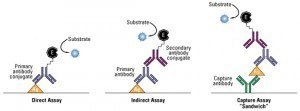 Enzyme-Linked Immunosorbent Assays (ELISAs) are the
most widely used type of immunoassay. ELISA is a rapid test used for
detecting or quantifying antibody or antigen against viruses, bacteria
and other materials.
Enzyme-Linked Immunosorbent Assays (ELISAs) are the
most widely used type of immunoassay. ELISA is a rapid test used for
detecting or quantifying antibody or antigen against viruses, bacteria
and other materials.
ELISA is so named because the test technique involves the use of an enzyme system and immunosorbent.
ELISA method for measuring Antigen (Ag) Antibody (Ab)
reaction is becoming increasingly used in the detection of antigen
(infectious agent) or antibody for its simplicity and sensitivity. It is
as sensitive as radioimmunoassay (RIA) and requires only microlitre
quantities of test reagents. It has now been widely applied in detection
of a variety of antibody and antigens such as hormones, toxins, and
viruses.
Some Salient Features
Some Salient Features
- ELISA test has high sensitivity and specificity.
- The result of quantitative ELISA tests can be read visually
- A large number of tests can be done at one time.
ELISAs are designed specifically for screening large numbers of specimens at a time, making them suitable for use in surveillance and centralized blood transfusion services - Reagents used for ELISA are stable and can be distributed in district and rural laboratories but as ELISAs require sophisticated equipment and skilled technicians to perform the tests, their use is limited to certain circumstances.
Materials needed in ELISA Testing
- Pipettes, Washer System, ELISA Plate Reader: Readers, washers and
pipette are available as manual or automated system. One of the main
factors affecting equipment selection is the number and types of test
samples being run.
- ELISA Readers: Readers need to have appropriate filter (650 nm and 450 nm).
- Pipette: Are available as fixed as well as adjustable volume as well as single channel and multi-channel.
- Washing system: It can be manual system that washes one row or column at a time or semi automated systems that wash one strip or plate at a time or fully automated systems that can process multiple plates
- Reagents needed for the testing- Concluded in the kit (Coated
plates, Sample diluents, Controls, Wash Concentrate, Conjugate,
Substrate, Stop solution)
- Coated plates: The 96-well plates are made of polystyrene and are coated with either inactivated antigen or antibody. The function of the plate has to hold the immobilized either antigen or antibody. Antigen or antibody present in the sample will bind to the plate. This coating acts as the binding site for the antibodies or antigens in the sample.
- Controls: Negative and positive controls are provided in each kit. The controls help to normalize or standardize each plate. Controls are also used to validate the assay and to calculate sample results. Controls might be pre-diluted and ready to use. (Please refer to kit for specific instructions).
- Conjugates: ELISA conjugates are enzyme labeled antibodies that react specifically to plate bound sample analytes. Unbound conjugates are washed away after incubation and before the addition of substrate.
- Wash Concentrate: It acts as a buffered solution containing detergent to wash unbound material from the plate. (Not all test kits have wash concentrate; in that case distilled water can be used for washing; please refer to kit insert for specific instructions)
- Stop solution: It stops the enzyme substrate reaction and color development.
Principle
Most ELISA methods developed for the detection of antigen or antibody consist of use of corresponding antibody or antigen in question which is firmly fixed on solid phase, such as plastic surface of polyvinyl plate or polystyrene tube, inside the well of a microdilution tray or outside of spherical plastic or metal bead. Such systems are also called Solid Phase Immunosorbent Assay.
Most ELISA methods developed for the detection of antigen or antibody consist of use of corresponding antibody or antigen in question which is firmly fixed on solid phase, such as plastic surface of polyvinyl plate or polystyrene tube, inside the well of a microdilution tray or outside of spherical plastic or metal bead. Such systems are also called Solid Phase Immunosorbent Assay.
The enzyme system consists of;
- An enzyme: horse radish peroxidase, alkaline phosphatase which is labelled or linked, to a specific antibody.
- A specific substrate:
- O-Phenyl-diamine-dihydrochloride for peroxidase
- P Nitrophenyl Phosphate- for Alkaline Phosphatase
Which is added after the antigen-antibody reaction.
The enzyme catalyses (usually hydrolyses) the substrate to give a colour
end point (yellow compound in case of Alkaline Phosphatase). The
intensity of the colour gives an indication of the amount of bound
antibody or antigen.
Most Commonly used ELISA are
a. ELISA for Antigen Detection
- Direct ELISA
- Indirect ELISA
b. ELISA For Antibody Detection
- Non Competitive ELISA
- Competitive ELISA
c. Capture ELISA



0 Comments:
Post a Comment